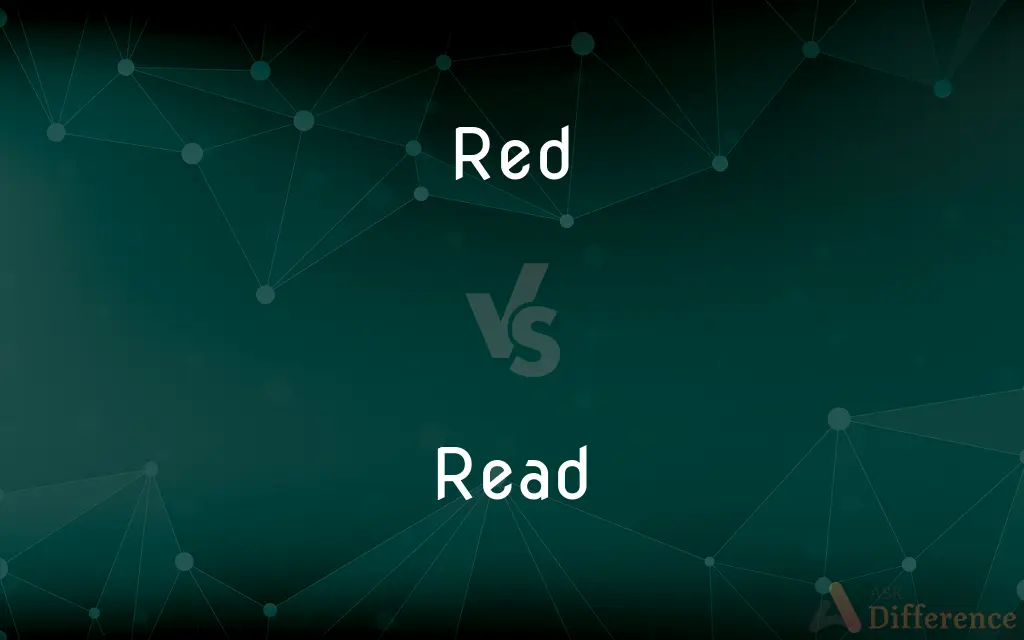Red vs. Read — What's the Difference?
By Urooj Arif & Fiza Rafique — Updated on March 4, 2024
Red emphasizes color, while Read highlights the process of understanding text.

Difference Between Red and Read
Table of Contents
ADVERTISEMENT
Key Differences
Red is a primary color perceived when light has a dominant wavelength of roughly 620-740 nanometers. It's a color associated with passion, danger, and excitement. Whereas, read refers to the process of looking at and understanding the meaning of written or printed matter. Reading can be done silently or aloud and is fundamental for communication, learning, and acquiring information.
Red is often used in various contexts to signal attention or caution, such as in stop signs and traffic lights. It's also a popular color in branding and marketing because of its ability to evoke strong emotions. On the other hand, read is an action that requires cognitive engagement with text or symbols to interpret and understand their meaning. It is a skill that develops over time and is essential for educational and personal growth.
Red is visually striking and can be used to draw attention in art, design, and fashion. It is one of the most visible colors to the human eye. Read, however, is an intellectual activity that involves recognizing words and sentences to comprehend their intended message. It is a mental process rather than a physical attribute.
Red has different meanings; in some cultures, it represents luck and prosperity, while in others, it can signify mourning. Read, in contrast, is universally recognized as a means of acquiring knowledge, understanding culture, and enjoying literature. The act of reading allows individuals to explore worlds beyond their immediate experience.
The significance of red can change depending on context, symbolizing love and passion in one setting and danger or warning in another. Meanwhile, the significance of reading remains constant as a vital tool for communication, education, and entertainment. The ability to read opens up endless possibilities for learning and engagement with the world.
ADVERTISEMENT
Comparison Chart
Definition
A color at the visible spectrum's end, associated with passion, danger, and urgency.
The process of interpreting written or printed material.
Context
Used in traffic lights, signs, and branding to convey important messages.
Essential for education, acquiring information, and leisure.
Physical vs. Mental
A physical attribute, visible to the eye.
A mental activity involving cognition and comprehension.
Cultural Significance
Varies globally, symbolizing emotions and events.
Universally valued as a key to knowledge and culture.
Purpose
To attract attention, signal caution, or evoke emotion.
To gain information, understand content, and enjoy stories.
Compare with Definitions
Red
A primary color that is one of the most easily perceived by the human eye.
The artist chose red to dominate her painting because of its boldness.
Read
Serves to inform, educate, entertain, or persuade.
The brochure reads well and provides all the necessary information about the tour.
Red
In many cultures, red signifies luck, happiness, or prosperity.
Red envelopes are given during Chinese New Year for good luck.
Read
Can be done in various formats, including books, articles, and digital media.
He prefers to read on his e-reader because it's more convenient.
Red
Often used in signs and signals to denote danger or stop.
The red stop sign at the corner alerts drivers to halt.
Read
A fundamental skill that is developed from an early age.
Children are taught to read using a combination of phonics and sight words.
Red
Evokes strong feelings such as love, anger, or urgency.
Red roses are a classic symbol of love and romance.
Read
The act of interpreting and understanding written or printed material.
She loves to read historical novels in her spare time.
Red
Has a high visibility, making it effective for warnings and attractions.
Emergency vehicles are often painted red to stand out.
Read
Requires cognitive engagement and comprehension.
Reading complex texts requires concentration and understanding of the subject matter.
Red
Red is the color at the long wavelength end of the visible spectrum of light, next to orange and opposite violet. It has a dominant wavelength of approximately 625–740 nanometres.
Read
To examine and grasp the meaning of (written or printed characters, words, or sentences).
Red
A pigment or dye having a red hue.
Read
To utter or render aloud (written or printed material)
Read poems to the students.
Red
Something that has a red hue.
Read
To have the ability to examine and grasp the meaning of (written or printed material in a given language or notation)
Reads Chinese.
Reads music.
Red
A red kangaroo.
Read
To examine and grasp the meaning of (language in a form other than written or printed characters, words, or sentences)
Reading Braille.
Reading sign language.
Red
A redshank.
Read
To examine and grasp the meaning of (a graphic representation)
Reading a map.
Read
To speak aloud the words that one is reading
Read to the children every night.
Read
To learn by reading
Read about the storm in the paper today.
Common Curiosities
What is the primary difference between red and read?
Red is a color, while read is the action of interpreting text.
Can the word "read" have different meanings?
Yes, it can refer to the act of reading in the past or present tense, depending on context.
Why might an artist choose to use red in their artwork?
To draw attention, convey strong emotions, or make a bold statement.
Why is red considered a powerful color?
Because it can evoke strong emotions and is highly visible, making it impactful for communication and design.
How does reading benefit the brain?
Reading improves cognitive functions, including memory, focus, and analytical thinking.
Is red always associated with danger?
Not always, its association can vary by culture, also symbolizing love, luck, or celebration in different contexts.
What are some challenges people might face with reading?
Dyslexia or other learning disabilities can make reading difficult, requiring specialized teaching methods.
How can someone improve their reading skills?
By practicing regularly, expanding vocabulary, and engaging with a variety of texts.
How does the color red affect human behavior?
It can increase heart rate and create feelings of urgency or arousal.
Is there a connection between reading and empathy?
Yes, reading literature can enhance empathy by helping readers understand diverse perspectives.
What role does reading play in education?
It's fundamental for learning, enabling access to knowledge across all subjects.
Can reading habits affect mental health?
Yes, reading can reduce stress, improve mood, and support mental well-being.
What technologies have impacted reading habits?
Digital devices like e-readers and tablets have changed how, when, and what people read.
Why is reading considered a fundamental skill?
Because it's essential for communication, learning, and participating fully in society.
How does the significance of red vary across different cultures?
It can represent anything from wealth and power to mourning, depending on cultural context.
Share Your Discovery

Previous Comparison
Got vs. Gotten
Next Comparison
Callous vs. CallusAuthor Spotlight
Written by
Urooj ArifUrooj is a skilled content writer at Ask Difference, known for her exceptional ability to simplify complex topics into engaging and informative content. With a passion for research and a flair for clear, concise writing, she consistently delivers articles that resonate with our diverse audience.
Co-written by
Fiza RafiqueFiza Rafique is a skilled content writer at AskDifference.com, where she meticulously refines and enhances written pieces. Drawing from her vast editorial expertise, Fiza ensures clarity, accuracy, and precision in every article. Passionate about language, she continually seeks to elevate the quality of content for readers worldwide.















































